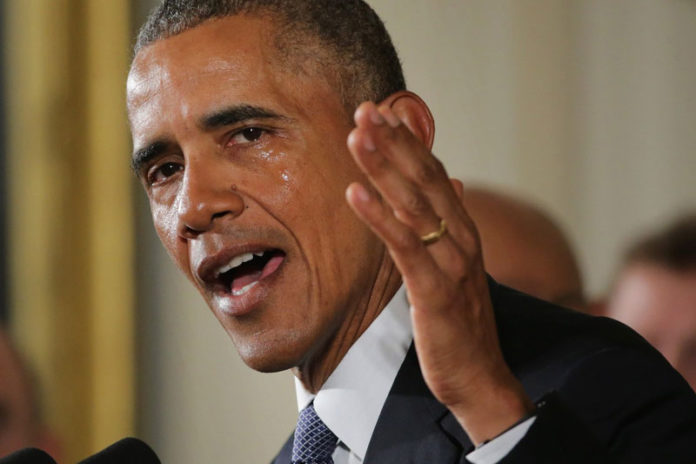On December 31st, people gathered across America and the world to welcome the New Year with joyous festivities, hopeful resolutions, and cheerful optimism about fresh starts. Bucking the trend, President Obama opted against such new beginnings and vowed instead to do in 2016 as he has the last seven years: Whatever he wants, regardless of what the Constitution, Congress, the Courts, or the public, has to say about it.
Using his vehicle of choice, Obama this week announced – with a flood of presidential tears – several “Executive Actions” aimed at restricting gun sales and ownership in the United States. Similar to his past moves, which range from further regulating healthcare to (illegally) expanding work permits for illegal immigrants, the President justified his unilateral policy decrees on a need to bypass an “ineffectual” Congress. Rather than actually traveling a few blocks up Pennsylvania Avenue to meet personally with congressional leaders, Obama chose again to chastise Congress for being held “hostage” by the “gun lobby.”
Obama’s teary-eyed efforts to rally supporters to his gun-control agenda every time a publicized mass-shooting occurs, has become something of a broken record. While the latest proposals – like those unveiled three years ago following the Newtown tragedy — appear on the surface to be largely benign, we had best take them seriously. As Ross Perot cautioned us, “the devil is in the details”; there is a relevant corollary to Perot’s maxim – “it’s often not what’s on the lines count; it’s what between the lines that matters most.”
Of most concern among the proposals is the Administration’s attempt to broaden the definition of who is “engaged in the business” of selling firearms; a classification which requires cumbersome licensing from the Bureau of Alcohol, Tobacco, and Firearms, in addition to dramatically enhanced penalties for violating the myriad regulations and conditions attendant to being a firearms dealer (a “Federal Firearms Licensee” or “FFL”). Yet, even the Administration is not clear on who would qualify. According to U.S. Attorney General Loretta Lynch, selling even one firearm could qualify an individual as a federal dealer, “depending on the circumstances” – vagueness not welcome from the person supposed to be the nation’s top lawyer.
In examining Monday’s decrees, Obama’s failure to propose even harsher gun control schemes as demanded by the Left, should not be viewed as a victory for Second Amendment supporters. The eventual goal of gun control advocates is not necessarily “gun control” per se, but ultimately reducing the number of firearms in circulation, and undermining the strength and authority of the Second Amendment. By simply making firearms more expensive to manufacture, and more complicated (and legally treacherous) to own or sell, the president’s “modest” proposals are every bit as dangerous as a move to outlaw certain categories of guns or ammunition; without the fuss of more direct measures that would never actually secure congressional approval.
Much like his Democratic predecessor Bill Clinton, Obama remains chronically apathetic towards the heavy-lifting required to work with Congress in order to pass his agenda through the regular constitutional process. But unlike Clinton, Obama detests the glad-handing, negotiations, and compromises with those he sees as beneath him; and finds it is far easier to use the “stroke of the pen” to accomplish his goals, regardless of the damage thereby done to such vital principles as limited presidential power and separation of powers between the branches of government. Whereas Clinton was relatively open with his Second Amendment agenda and proposed mostly symbolic policies designed to score political points, Obama has chosen to work in the shadows via non-legislative means that strike more calculated blows to heart of gun rights. And his efforts in this regard are many.
Consider the Obama Administration’s signing of the “Arms Trade Treaty” (ATT), which even without ratification by Congress, means the U.S. is “obligated” not to act “contrary to” the gun-control efforts proffered by the treaty explicitly or in ancillary documents. Or, “Operation Choke Point” in 2014, when Obama ordered the Department of Justice and the Federal Deposit Insurance Corporation (FDIC) to pressure banks to dry up financial funding critical to firearms transactions and firearms-related companies. Or, how Obama has attempted to shoehorn the Centers for Disease Control into the gun control debate in an ongoing attempt to make gun violence a “public health” crisis; thereby subject to Food and Drug Administration regulatory control.
These are but a few examples of the many calculated moves by the Obama Administration over the last seven years designed to circumvent Congress, and gut the Second Amendment without subjecting himself or his proposals to real debate. The new round of executive actions is more of the same, regardless of how “modest” the President and his allies claim them to be.
Each step down this path opens the door wider for subsequent administrations to take the same approach regarding other issues. Whether this Congress, unlike its predecessors, recognizes this long-term damage and takes steps to stop the Administration, is – unfortunately – unlikely.































